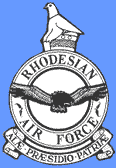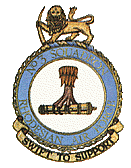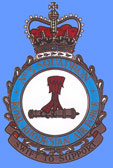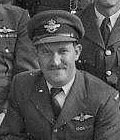A Tech's View 3 Sqn Photo Gallery Air Force Home Page Site Home Page Contact Us
Formation
No 3 Squadron was formed in 1953.
Motto
"Swift to Support"
Roles
The role of No 3 Squadron was that of air support, para
trooping, re-supply, sky shouting, search and rescue and, air
communications including VIP transport.
A Brief History
1947
The unit was originally established in 1947 as a communications flight
operating Douglas C47 aircraft.
1953
It became No. 3 Squadron in 1953 and was based at New Sarum Air Base,
south of Salisbury, operating two Pembroke C1 aircraft in addition to
the C47s.The Pembroke's were retired from service in July 1963. The
Squadron was used during the first Vampire ferry to position spares and
servicing teams along the route.
1959
During the Nyasaland Emergency in 1959 the squadron airlifted troop to
Blantyre in Nyasaland (now Malawi).
With the formation of C Squadron Special Air Service Regiment the squadron took on a new role, that of paratroop dropping. This role was to remain for many years.
During 1959 the squadron was augmented with four C4 Argonauts. These were phased out in August 1964.
1960
In 1960 the Squadron was called upon to assist with the Katanga crisis.
The squadron flew day and night ferrying people from Katanga to
Salisbury and transporting rations and bedding on the return trips.
When the state of emergency was declared in Kuwait No. 3 Squadron the Canadairs were deployed to Kormaksar to assist in moving troops of the British Army from Kenya to Kuwait.
1963
5th January 1963 the first three RRAF VR's started routine flying with
No 3 Sqn.
31st December 1963 No. 3 Squadron was reduced to an aircraft strength to four Canadairs and Four Dakotas
1964
1964 the aircraft silver paint scheme changed to two tone green
camouflage.
During March 1964 the weekly shuttle New Sarum – Thornhill – Kumalo (Bulowayo) was inaugurated by No. 3 Squadron.
The four C4 Argonauts were phased out in August 1964.
1967
No. 3
squadron received one Trojan for light transport work.
In
1967 the Squadron acquired a Beech Baron R7310 for use in the VIP
communication role. Only a few squadron crews were trained to operate
this aircraft This aircraft was retired in November 1976.
May 1967 No. 3 Squadron celebrated 21 years of service. The Squadron at that time had 8 Dakotas, 1 Baron and1 Trojan aircraft. The Squadron was commanded by Squadron Leader Peter Barnett and the aircraft were flown by 12 regular pilots, and 6 VR pilots.
No 3 Squadron became engaged in rain making due to finance being made available to the University of Rhodesia for the project. The project was a co-operation between the Air Force, the University, the Meteorological Office and the Office of Statistics. And was controlled by the committee (CoCCSE) Committee to Co-ordinate the Cloud Seeding Experiment.
A Dakota aircraft 7307 was fitted with two burners in which silver iodide and acetone were pumped, mixed and ignited. The resulting microscopic smoke particles was vented into the clouds via two streamlines pods. One on either side of the rear fuselage just forward of the freight door. The burners were fed from a 14 gallon tank fitted inside the aircraft.
Cloud seeding continued each summer until the aircraft was written off in a ground loop at Rushinga airfield.
The technical problems were considerable and involved a major modification to the aircraft was well as the design and manufacture of measuring instrumentation.
1968
The Squadron
carried
out sky-shouting trials.
Two large loudspeakers were fitted
in the doorway of the Dakota. From these loudspeakers voice messages
were beamed down to
the ground.Sky shouting was carried out in areas where it was known
that terrorists were operating and was often used in conjunction with
leaflet dropping. The aircraft would be flown in a gentle turn to port
(left) at a height of 1,500 to 2000feet above the ground.
On
one occasion the aircraft flown by Flt Lt Ed Paintin was hit by a 7.63
round fired from the ground, whilst sky-shouting over the Madziwa
Tribal Trust area. The bullet entered the aircraft below the engineers
seat and lodged in the base of his toolbox. No other damage was done to
the aircraft. The audio tapes for the Shy shouts varied according to
the message the security forces wanted to convey. These tapes were
produced by Psyops.
In 1968 and throughout the
Rhodesia Conflict No. 3 Squadron was used to re supply forward
airfields and to move troops to forward areas.
1969
In June 1969 a Dakota carrying Army VIPs whilst landing a Chirundu
developed a wheel fire that set fire to the grass. The crew quickly
extinguished the grass fire.
October 1969 saw a Dakota of No. 3 Squadron engaged on a search and rescue for Flying Officer Jim Stagman and Flight Lieutenant Dave Postance who ejected from their Canberra aircraft over the Wankie National Park.
1970
In 1970 during Operations Teak and Birch, No. 3 Squadron was engaged in
"sky shouting" as part of the psychological warfare effort. At times
the aircraft were used to drop leaflets over wide areas.
During July 1970 No. 3 Squadron were involved in a shy shout in the Mueda area of northern Mozambique (Operation Bush Pig).
During the conflict the aircraft were painted with a non reflective paint to reduce their susceptibility to heat seeking missiles. At the same time the exhausts of the engines were fitted with a device to reduce the temperature of the exhaust gasses and so prevent the heat seeking missiles from acquiring the aircraft.
During the early 1970s two of DC3s (R7036 and R7134) were configured as VIP aircraft, these were used extensively to transport the President, Prime Minister and Cabinet Ministers.
Another aircraft (No 7303) was equipped with rain making equipment. Acetone and silver iodide were burned in a special burner to create tiny hygroscopic particles which when introduced into clouds, caused rain to fall. It was named "Chaminuka" after the local African rain god. Unfortunately this aircraft was destroyed in an accident on the 31st February1975.
1971
During 1971 the squadron acquired one Trojan aircraft for light
transport. Only a small number of squadron crews were trained to fly
this aircraft.
During 1971 No 3 Squadron was kept busy with Operation Jacaranda, which replaced Operation Apollo. The rain making project, Operation Tarpaulin continued to consume many hours. This was the third and final year of the project.
During
September and October intensive free-fall parachute training was
carried out at Cranborne. This included night descents.
During the rainy season 1970/1971 No 3 Squadron pilots again found
themselves cloud seeding when the request came from the Meteorological
Office for a bonus year.
1972
6th June 1972 saw the squadron swing into action in support of members
of the rescue teams that were descending on Wankie Colliery where a
huge methane gas explosion tore through No 2 Shaft, trapping hundreds
of miners below ground. Four hundred and sixty five miners died.
Because of the danger to others in the operation to recover the bodies
it was decided that their bodies would sealed off at the bottom of the
Kamandama and Central Shafts. Only one very fortunate miner was brought
to the surface alive.
1973
In March 1973 two Dakota aircraft R3711 and R7312 arrived from South
Africa to augment the fleet.
1974
January 1974 a Dakota Flown by Flight Lieutenant Ed Paintin was hit by
ground fire during a sky shout operation. This was the first No. 3
Squadron to be hit by by enemy fire.
On the 16th
April 1974 two Dakota aircraft R7313 and R7134 from Central African
Airways joined the squadron. R7134 was kept in VIP configuration and
used extensively to fly the President, Prime Minister Ian Smith and
other VIPs around the country
In May of 1974 the
first Volunteer Reserve Captain was appointed on No 3 Squadron. He was
Flight Lieutenant George Walker-Smith.
1975
On
21st February 1975 Dakota R7307 was intentionally ground looped whilst
landing at Rushinga. During the ground loop the undercarriage collapsed
causing the aircraft to be classified Cat 5. The crew Flt Lt Ed Paintin
, Flt Lt Frank Wingrove were uninjured. The engineer Corporal John
Mitchell suffered minor injuries to his head as the port propeller tore
into the cockpit area behind the pilots seat.
On the 7th April 1975 No 3 Squadron was presented with it's Colours by Air Vice Marshall Harold Hawkins.
On the 10th October 1975 the squadron received a Cessna 421C from South Africa for use by No 3 Squadron.
1976
During 1976 a Douglas DC-7CF was placed on the fleet. This saw service
until November 1980.
On the 29th June 1976 the first of six Brittin Norman Islanders (BN-2A) aircraft was acquired by the Rhodesian Air Force. Between June 1976 and November 1979 a total of six BN-21 aircraft were acquired from various sources in Mozambique, South Africa and Angola.
On the 4th November 1976 the Beech Baron R7310 was damaged the undercarriage collapsed on landing at Perrem airfield near Umtali. The pilot Flt Lt Mike Russell and General Peter Walls his VIP passenger were not injured in the accident. The recovery team caused further damage during the recovery and the decision was made to sell the aircraft as a wreck. The overall damage was assessed as Cat 4. The aircraft was subsequently rebuilt
1977
On the 7th January 1977 Dakota R7034 was written off when it hit
overhead wires as it was flying low level in the Buffalo Range area.
Squadron Leader Peter Barnett, Flight Lieutenant Dave Mallett and
Corporal A. Bradley (army) were killed. The flight engineer and four
army dispatchers survived the accident.
On the 31st May 1977 Dakota R3702 was destroyed when it was hit by an RPG7 rocket during its take off run at Mapai. Flight Lieutenant Gerry Lynch and Sergeant R. Wantenaar survived but regrettably Flight Lieutenant Bruce Collocott was killed instantly.
During 1977 three Dakota aircraft R7310, R3700 and R7301 arrived on the squadron via various routes.
1978
On the 15th February 1978 the Britten Norman Islander R3718 was
destroyed at Derowa when it failed to get airborne carrying a load of
parachutes. The pilot was Flt Lt Bernie van Huysteen.
Later in about 1978 one of the Dakota aircraft was configured as an airborne Command Post and another for electronic intelligence gathering.
1980
On the 18th December 1980 Dakota 3711 was destroyed.
Post
Zimbabwe Independence
On the
12th March 1983
the squadron was re-equipped with twelve CASA C-212 aircraft to
replace the Dakotas
During 1989 a single Sia Machetti 260TP was transferred to No. 3 squadron.
Squadron Commanders
Sqn Ldr W.H.Smith To 1968 |
Sqn Ldr M.D.Gedye Sept 68 - Feb 72 |
|
|
Dakotas of No 3 Squadron
Nineteen different Dakotas were flown by No 3 Squadron from 1947 to 1991. They flew a total of 82,280hrs and 50 minutes.
The aircraft with the least total hours was Chaminuka which only had 5,818 hours when it was written off in February 1975 after a serious ground loop at Rushinga. Chaminuka was delivered to the Royal Air Force on 28th March 1945 in Montreal as KN471, then to the Middle East on the 11th April 1945, then to the South African Air Force as 6963 on the 27th September 1945. She came to the Royal Rhodesian Air Force as 707 VP-YZE in January 1964.
The Dakota with the most hours was R7310 Serial No. 42978. She flew with the Douglas Aircraft Company as NC 34982, then to Swiss Air as HB-IRC on 15th April 1946, then to Protea Airways (South Africa) as ZS-FRJ on 9th May 1946. She then went to Swazi Air as 3D-ABF in December 1973, then back to Protea Airways as ZS-FJR on the 11th May 1977, then to Aviation Equipment and on to No 3 Squadron later in 1977 as R7310. As at the 11th June 1991 she was still with the Air Force of Zimbabwe and had flown 29,515 hours and 15 minutes.























